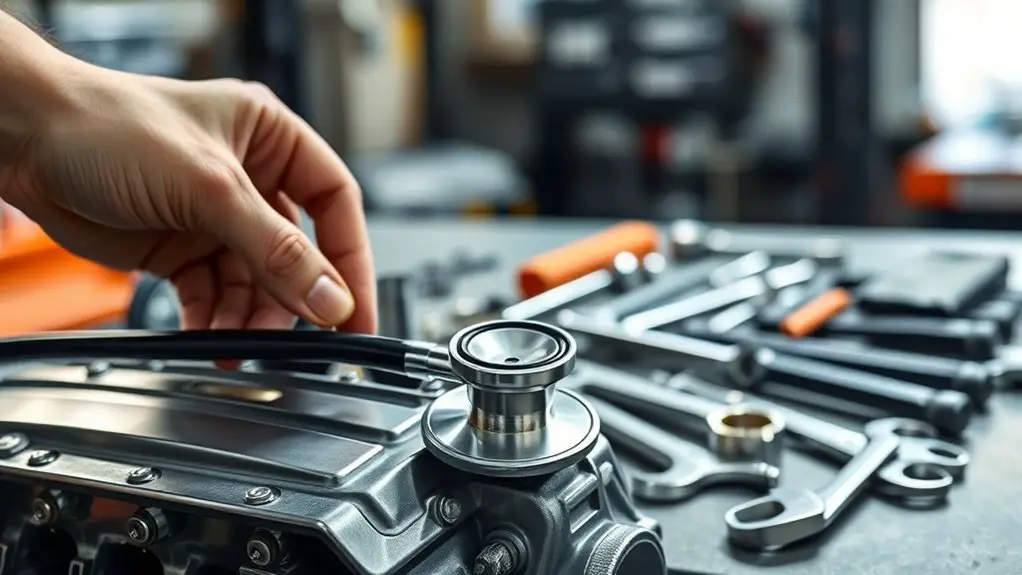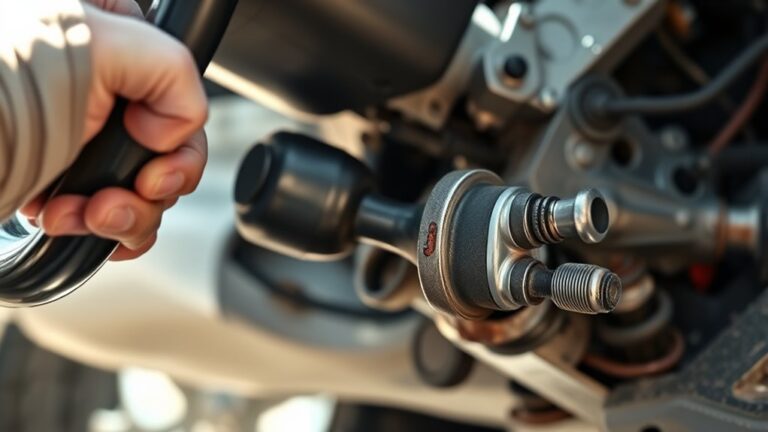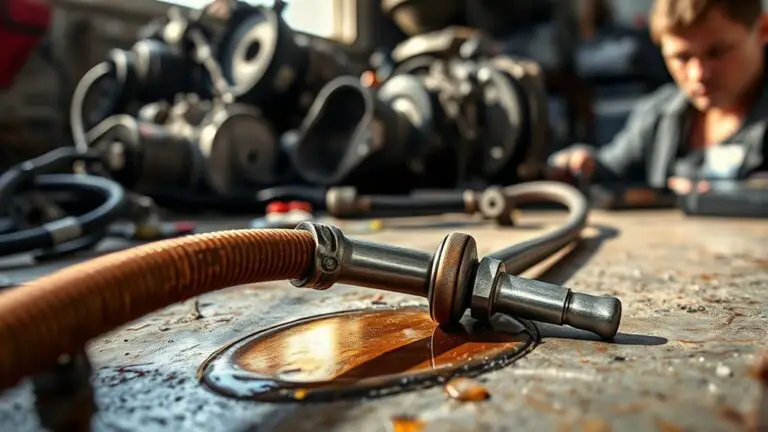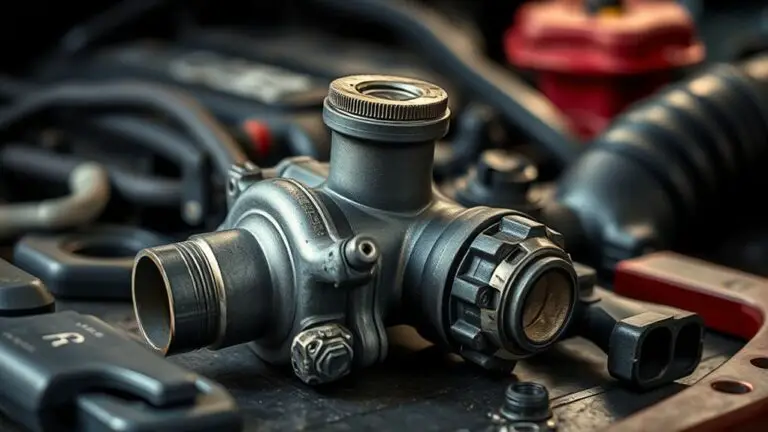Tool Guide: Using a Mechanic’s Stethoscope to Diagnose Timing Noise
To diagnose timing noise with a mechanic’s stethoscope, position the microphone against engine components, especially near the timing cover and valve cover. Listen for irregular sounds like rattling or ticking, which indicate potential issues. Adjust the microphone’s position for clarity and compare sounds with a known healthy engine. Document your findings to track changes and refine your diagnosis technique. With practice, you’ll enhance your ability to identify problems effectively. There’s more to explore on ensuring accurate diagnoses.
Understanding the Mechanic’s Stethoscope
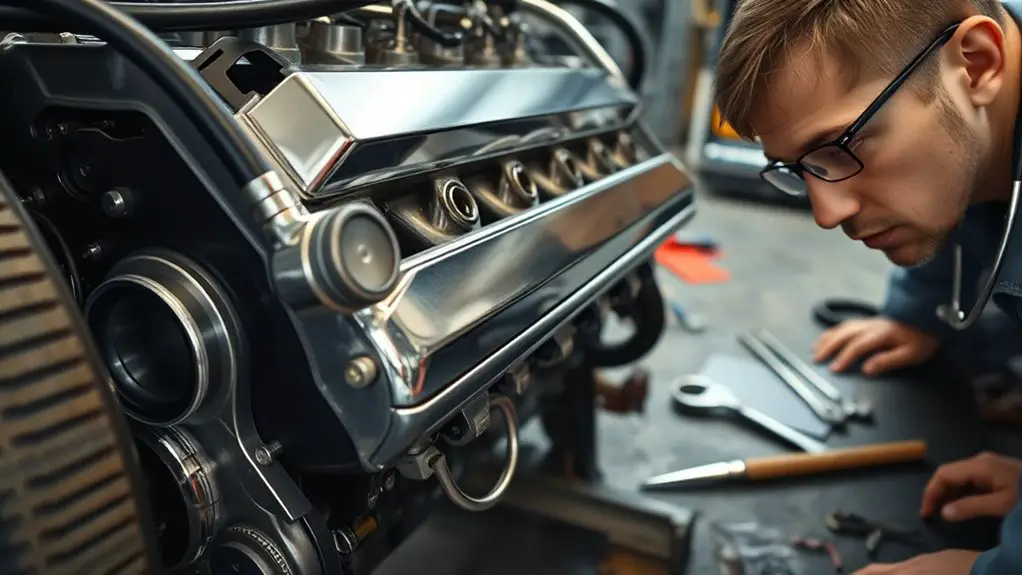
A mechanic’s stethoscope is an essential diagnostic tool that helps identify sounds within an engine or other mechanical systems. This tool features a long, flexible tube connected to a microphone, enabling you to listen closely to various components like bearings, valves, and pumps. Its design allows for precision, isolating specific sounds that might indicate mechanical issues, such as wear or misalignment.
The benefits of using a mechanic’s stethoscope are significant. It enhances your ability to diagnose problems early, potentially preventing costly repairs down the line. By accurately pinpointing the source of abnormal noises, you gain valuable insights into the health of the engine or system. This tool’s portability and ease of use empower you to carry out inspections swiftly, ensuring you can maintain your freedom in tackling mechanical challenges without unnecessary complications. With a mechanic’s stethoscope, you’re equipped to achieve greater efficiency and reliability in your repairs.
How to Properly Use a Mechanic’s Stethoscope

To effectively use a mechanic’s stethoscope, start by confirming the tool is properly assembled and the microphone is functioning. This guarantees you’re set up for accurate sound identification. Follow these steps for proper technique:
- Positioning: Place the stethoscope’s microphone against different engine components, starting with the valve cover or timing chain cover.
- Listening: Pay attention to the sounds you hear. Is it a rhythmic ticking or a more constant noise?
- Adjusting: If the sound is faint, adjust the microphone’s position for better contact. Sometimes, a slight shift can make a significant difference.
- Comparing: Use the stethoscope to compare sounds from various parts of the engine. This can help pinpoint the source of the noise.
Identifying Common Timing Noise Issues

Using a mechanic’s stethoscope can help you pinpoint timing noise issues that may indicate underlying problems in your engine. A common issue involves a worn or loose timing chain, which can produce a rattling or slapping sound, especially during acceleration. Listen closely around the timing cover; if you hear these noises, it could mean the timing chain needs replacement.
Another potential culprit is improper valve adjustment. If the valves are too tight or too loose, you might hear a ticking or tapping noise. Position the stethoscope near the valve cover to detect these sounds.
Tips for Accurate Diagnosis
While diagnosing engine issues with a mechanic’s stethoscope, it is crucial to approach the task methodically. Accurate diagnosis hinges on effective noise interpretation and applying the right diagnostic techniques. Here are some tips to enhance your accuracy:
- Isolate the Noise: Place the stethoscope directly on suspected components to pinpoint the source, reducing interference from other engine noises.
- Listen Carefully: Pay attention to variations in sound. Different pitches or rhythms can indicate specific issues, aiding in effective interpretation.
- Compare Sounds: Use your stethoscope on a similar, healthy engine to establish a baseline for normal sounds, helping you identify anomalies.
- Document Findings: Keep notes on what you hear during each session. This record can assist in tracking changes and refining your diagnostic techniques over time.
Maintaining Your Mechanic’s Stethoscope
A mechanic’s stethoscope is an essential tool for diagnosing engine issues, but its effectiveness relies on proper maintenance. Regular care guarantees longevity and accuracy, so follow these cleaning techniques and storage best practices:
| Task | Frequency | Method |
|---|---|---|
| Clean earpieces | After each use | Wipe with a damp cloth |
| Inspect tubing | Weekly | Check for cracks or leaks |
| Store in a protective case | Always | Use a hard case to prevent damage |
| Replace worn parts | As needed | Order from the manufacturer |
Frequently Asked Questions
Can a Mechanic’s Stethoscope Be Used for Other Automotive Noises?
Yes, a mechanic’s stethoscope can definitely be used for other automotive noises. This diagnostic tool allows you to pinpoint various engine noises, such as valve tap, bearing issues, or fuel injector sounds. By placing the stethoscope on different engine components, you can isolate and identify the source of the noise. It’s essential for any mechanic seeking to enhance their diagnostic skills and efficiently address issues, ensuring your vehicle runs smoothly.
What Is the Cost Range for a Mechanic’s Stethoscope?
A mechanic’s stethoscope typically costs between $10 and $100. If you’re looking for budget options, you can find basic models under $20, but they may lack durability. For more reliable performance, quality brands range from $30 to $100, offering better sound clarity and comfort. Investing in a higher-end option guarantees you’ll have a tool that lasts, making it easier to diagnose various automotive noises effectively.
Are There Any Safety Precautions When Using a Mechanic’s Stethoscope?
When using a mechanic’s stethoscope, it’s essential to wear appropriate safety gear, like gloves and eye protection, to guard against unexpected hazards. Always verify the vehicle is securely parked and the engine is off before positioning yourself near moving parts. Use proper techniques by keeping your hands clear of any rotating components and maintaining a safe distance from hot surfaces. This guarantees your safety while effectively diagnosing any issues.
How Do I Choose the Right Mechanic’s Stethoscope for My Needs?
Choosing the right mechanic’s stethoscope is like picking the perfect tool for a delicate surgery. Start by comparing features across different stethoscope types, focusing on sensitivity and build quality. If you need precision for intricate tasks, opt for an electronic model; otherwise, a traditional one might suffice. Consider your budget and specific needs, ensuring it feels comfortable in your hands. The right stethoscope can empower you to diagnose issues with confidence and clarity.
Can I Use a Smartphone App Instead of a Mechanic’s Stethoscope?
You can use a smartphone app instead of a mechanic’s stethoscope, but there are limitations to take into account. While some apps offer decent sound amplification, their accuracy can vary greatly, often depending on your device’s microphone quality. This means you might miss subtle noises that a stethoscope can easily detect. If you’re seeking precise diagnostics, investing in a stethoscope is often the better choice for reliable and detailed sound analysis.

